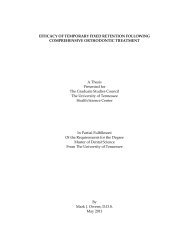BEVACIZUMAB EFFECT ON TOPOTECAN PHARMACOKINETICS ...
BEVACIZUMAB EFFECT ON TOPOTECAN PHARMACOKINETICS ...
BEVACIZUMAB EFFECT ON TOPOTECAN PHARMACOKINETICS ...
You also want an ePaper? Increase the reach of your titles
YUMPU automatically turns print PDFs into web optimized ePapers that Google loves.
CHAPTER 2. THE <strong>EFFECT</strong> OF <strong>BEVACIZUMAB</strong> <strong>ON</strong> THE<br />
<strong>PHARMACOKINETICS</strong> OF <strong>TOPOTECAN</strong> IN A RH30<br />
RHABDOMYOSARCOMA XENOGRAFT<br />
2.1 Introduction<br />
In order to gain sufficient nutrients and oxygen for growth, tumor cells secret and<br />
recruit pro-angiogenic factors for the creation and maintenance of the vascular network in<br />
solid tumors [14]. As a result, the tumor vasculature is chaotic, the blood vessel walls are<br />
heterogeneous and the microenvironment is compact and has an interstitial hypertension<br />
and aberrant metabolic environment─all of which can be restored by anti-angiogenic<br />
treatments [6, 31, 53, 170]. VEGF is a key regulator of tumor angiogenesis [65, 66, 69].<br />
It helps recruit of bone-marrow-derived progenitor cells to the primary and metastatic<br />
sites to form a new vascular network to stimulate tumor growth. In addition, VEGF not<br />
only promotes proliferation, migration, and invasion of endothelial cells to maintain<br />
tumor vessel growth, but also inhibits endothelial cell apoptosis to facilitate tumor vessel<br />
survival. Furthermore, the overexpression of VEGF is frequently observed in human<br />
solid tumors, which is found to correlate with the extent of tumor angiogenesis,<br />
progression and survival in patients [67, 68]. Thus, inhibiting VEGF represents a rational<br />
strategy in treating various malignant tumors.<br />
Rhabdomyosarcoma is the most common soft tissue sarcoma among children 0-14<br />
years, representing nearly 50% of soft tissue sarcomas [171]. The two most common<br />
pathologic types of RMS are embryonal RMS (ERMS) and alveolar RMS (ARMS) with<br />
differential incidence, age pattern and body sites of occurrence [102]. ARMS grow more<br />
aggressively than ERMS and require more intensive treatment. Therefore they have a<br />
higher relapse incidence and worse prognostic outcome [109]. The 5 year failure-free<br />
survival rate for ARMS (65%) is much lower than ERMS (82%) [172]. In addition, 30%<br />
of young patients experience recurrence and 50% to 95% of these patients die of<br />
progressive disease, even with intensified treatment [112]. So developing new agents or<br />
new strategies to increase current agent efficacy is urgent for the treatment of RMS,<br />
especially ARMS.<br />
Bevacizumab (BEV) is a humanized monoclonal antibody that inhibits VEGF and<br />
currently used to treat various cancers, including colorectal, lung, breast, kidney cancers,<br />
and glioblastoma [173]. It is also in clinical trials for the treatment of RMS in<br />
combination with traditional cytotoxic chemotherapy [174, 175]. However, the effect of<br />
dosing schedule of BEV in combination with cytotoxic drugs is not well understood. The<br />
Rh30 cell line retains the histologic appearance of ARMS [176]. VEGF is over-expressed<br />
in the Rh30 cell line and anti-VEGF treatment has been shown to inhibit the growth of<br />
Rh30 RMS xenograft [115]. The Rh30 cell line is more sensitive to Topotecan (TPT)<br />
than RD cell line, characterized as ERMS cell line [116]. TPT has been actively<br />
investigated in clinical trials and had an encouraging response rate in ARMS patients<br />
[177]. However, preclinical and clinical studies showed that RMS is resistant to TPT as<br />
20
















